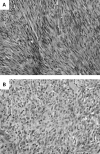Colorectal gastrointestinal stromal tumors: a brief review
- PMID: 20011313
- PMCID: PMC2780110
- DOI: 10.1055/s-2006-942347
Colorectal gastrointestinal stromal tumors: a brief review
Abstract
Gastrointestinal stromal tumors (GISTs) are rare lesions that constitute the majority of mesenchymal tumors in the gastrointestinal tract. Within the colon and rectum, they represent 0.1% of all cancers. They can present with a variety of symptoms but are often asymptomatic. Although many lesions may be benign, up to half of patients develop recurrent disease within a few years. Almost all GISTs contain a mutation in the c-kit tyrosine kinase that leads to its constitutive activation and results in cell proliferation. This discovery has led to the immunostaining of the c-kit antigen (CD117) to distinguish GISTs from other malignancies. Radiologic examinations can be helpful in initial diagnosis and staging. Surgery is the best treatment for cure, but recent advances have led to the use of imatinib mesylate, a tyrosine kinase inhibitor, to treat metastatic or unresectable disease, or both. There are currently many clinical trials available to help treat GISTs.
Keywords: CD117/c-kit; Gastrointestinal stromal tumors; colon cancer; imatinib mesylate; surgery.
Figures




References
-
- Pidhorecky I, Cheney R T, Kraybill W F, Gibbs J F. Gastrointestinal stromal tumors: current diagnosis, biologic behavior, and management. Ann Surg Oncol. 2000;7:705–712. - PubMed
-
- Miettinen M, Majidi M, Lasota J. Pathology and diagnostic criteria of gastrointestinal stromal tumors (GISTs): a review. Eur J Cancer. 2002;38(suppl 5):S39–S51. - PubMed
-
- Stout A P. Bizarre smooth muscle tumors of the stomach. Cancer. 1962;15:400–409. - PubMed
-
- Appelman H D. Smooth muscle tumors of the gastrointestinal tract. What we know now that Stout didn't know. Am J Surg Pathol. 1986;10(suppl 1):83–99. - PubMed
-
- Mazur M T, Clark H B. Gastric stromal tumors: reappraisal of histogenesis. Am J Surg Pathol. 1983;7:507–519. - PubMed
LinkOut - more resources
Full Text Sources
Other Literature Sources

